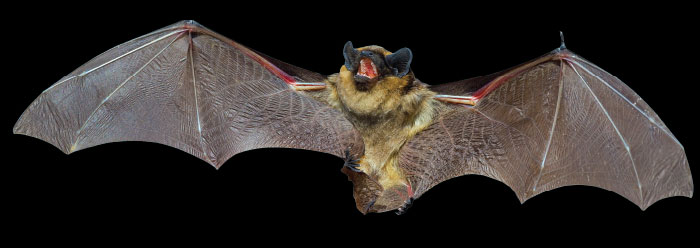Of the 1,240 living mammal species, almost 25 percent are the amazingly designed bats.1 They compose the second-largest order of mammals, next to rodents,2 and are ecologically and economically important. Bats effectively control insect pests and are essential to the pollination of some flowers. In fact, a number of tropical plants depend entirely on bats for seed dispersal. Mammologists place these nocturnal creatures into two suborders—the Microchiroptera (echolocating, insect-eating bats) and Megachiroptera (fruit-eating bats). According to evolution, both groups evolved from an unknown flying common ancestor.
Bat Origins
Evolutionists maintain that a rodent of some sort evolved into a bat. Yet, over 1,000 fossil bats have been unearthed and scientists have not classified a single one as an intermediate between rodents and bats. They’re all bats, as predicted by the creation model.
If there was ever such a great transformation, evolutionarily speaking, it would be a remarkable transition from an unknown rodent to a swift-flying bat. How do evolutionists account for this? Strangely, a 2007 book edited by two evolutionists titled Major Transitions in Vertebrate Evolution3 does not explain the process. Neither does Great Transformations in Vertebrate Evolution, published several years later.4 Why the silence on bat origins?
The phylogenetic (evolutionary) relationship of different groups of bats is contentious, and no evidence exists for an evolutionary transition from rodents to bats. Indeed, an intermediate form is hard to imagine since rodents have front legs designed for the tetrapod (four-footed) lifestyle. Evolutionary theory suggests that through a large number of unknown beneficial mutations, these front legs evolved into highly articulated bones for flight and added the two dozen independent joints and membranous wings (patagium) that we see in bats. Not surprisingly, evolutionists themselves state, “There are no known intermediate stages between bats and insectivores.”5 Bats are 100 percent bat from their first appearance.
Bat Wings
The earliest fossil bats resemble their modern counterparts in possessing greatly elongated digits to support the wing membrane, which is an anatomical hallmark of powered flight.6
Bats flap only their digits, not their entire forearms as birds do. So, according to evolutionists, other than the normal thumb with a claw, the four short toes of the alleged non-flying bat ancestor slowly and gradually extended into the greatly elongated digits (metacarpals 2-5) seen in bats today. Zoologists observe that bats’ fine-tuned wing movement—due to the reshaping and stretching of the webbing and hand—is responsible for their fantastic flying abilities.
Their agility in the air demands quick, precise wing movements and a constant adjustment of tiny muscles in the wing membrane. They also use their wings for other delicate tasks, like holding food and cradling young. To adjust their complex wings for the job at hand, they must integrate a variety of sensory feedback.7
For those willing to acknowledge it, the intentional design in bat wing construction is obvious. Researchers at Brown University stated in a news release that
Birds and insects can fold and rotate their wings during flight, but bats have many more options. Their flexible skin can catch the air and generate lift or reduce drag in many different ways. During straightforward flight, the wing is mostly extended for the down stroke, but the wing surface curves much more than a bird’s does—giving bats greater lift for less energy. During the up stroke, the bats fold the wings much closer to their bodies than other flying animals, potentially reducing the drag they experience. The wing’s extraordinary flexibility also allows the animals to make 180-degree turns in a distance of less than half a wingspan.8
One must ask just how untold billions of intermediate creatures (not a rodent but certainly not yet a bat) survived for millions of years while waiting for such well-constructed wings and prey-catching abilities. Of course, the fossil record does not reveal such a fantastical transition but instead shows that bats have always been bats. This was shown to be true as far back as the early Eocene with the discovery of Onychonycteris and Icaronycteris, which are described as “reasonably complete bat fossils.”9 They possess key features of the small insect-eating bats (Microchiroptera): the four elongated digits, a living flight membrane with specialized muscles, sensors, and elastic fibers, and “the feet are turn backwards so that these early bats could hang upside down as modern bats do.”10
God created bats with unique bone morphogenetic proteins referred to as Bmps, a family of multifunctional proteins present in mammals. As a bat develops embryonically, a crucial gene controlling Bmp signaling, called Bmp2, is expressed in the developing forelimbs. This accelerates their finger elongation. If evolution were true, we should find early bat fossils with shorter fingers. Through the millennia, digit length should increase, reflecting increased Bmp2 activity caused by genetic mutations. Scientists should observe accompanying changes in a variety of interconnected controlling factors such as regulatory RNAs, epigenetic controls, and a variety of regulatory DNA sequences in and around the Bmp2 gene.
All these fine-tuned critical factors must be in place all at once for the whole system to make a proper bat wing. And an early bat fossil dated at “50 million years” revealed no noteworthy increase in digit proportion. Creation scientists see this as evidence that bats have always reproduced after their kind, with developmental genes and their regulatory systems, such as Bmp2, in place from the beginning.
The supposedly 50 million-year-old fossil does not show any evolution from an alleged common ancestor. But evolutionists maintain that the consistency of bat wings throughout the fossil record is only an indication that genes remained unchanged over large expanses of evolutionary time—a concept called conservation.
Evolutionist Michael Denton weighs in on the elongated and webbed hand of the bat, saying,
This implies that the actualization of this remarkable novelty has involved what would appear to be complex simultaneous compensatory recruitment of new gene circuits, which operate in unison to generate long fingers and the intervening webbing—a finding at odds with the Darwinian conception that novelties emerged gradually via a succession of individual genetic changes.11
In other words, Denton claims the appearance of elongated fingers and webbed wings in bats throughout the fossil record means that multiple necessary traits must have evolved at the same time through complex genetic interactions. This contradicts the gradual accumulation of mutations over time that Darwinian evolution expects. But bats appearing in the fossil record with the ideal design from the get-go is much better explained by the Genesis account of an omniscient Creator.
Bat Sonar
Biological sonar, or echolocation, uses sound to “see.” The biological equipment that grants this God-designed ability in bats is smaller, weighs less, and yields higher resolution than man-made sonar equipment. Could such design really evolve? As evolutionary paleontologist Michael Benton admits,
The evolution of echolocation in bats has been hard to resolve.12
Bats “see with sound” by emitting narrow beams of frequency-modulated sounds (ultrasounds) that are projected from their larynxes and out their mouths. They vocalize faster as they near their targets, giving them the higher resolution required to catch their prey. The bat evaluates the returning signals picked up by its uniquely shaped ears and uses them to “paint” a mental image of its surroundings. The sonar image is as well-defined as the visual images of human and diurnal (daytime) animals.
Bats can effortlessly fly around obstacles in pitch-black darkness. Their sonar sensibilities rapidly detect the flying insects such as mosquitoes they love to eat. The bat can even instantly determine the type of insect it is chasing, but to do this it must vocalize high-pitched, high-energy pulses that would soon damage its own inner ear tissue. With the emission of such sharp and repeated blasts of ultrasonic energy, one must ask how they avoid deafening themselves. The Creator solved this problem by designing a tiny skeletal muscle attached to the bat’s miniscule hearing bones. The muscle contracts during each emitted sound pulse, protecting the sensitive inner ear. But the bat must hear returning pulses at the same time, especially as it closes in on the prey. In order to hear these returning pulses, the muscle relaxes to re-engage the bones 10 or more times per second.
One would think insects such as moths wouldn’t have a chance against the efficient bat sonar. However, God has created defensive abilities for a number of insects, giving them a chance for evasion. Certain moths such as the tiger moth can detect bat sonar and use a sonar-jamming defense method. Just when the bat closes in on the hapless moth, the moth emits ultrasonic counter-clicks to jam the bat sonar. The clicks are so rapid that they sound like a siren, briefly confusing the bat and allowing the moth to escape.13
Hibernation
Bats are also true hibernators. The design features that allow these flying mammals to undergo a period of winter inactivity are incredible. God designed the hypothalamus portion of the brain to slow the bat’s respiration, heart, and metabolic rate. The hypothalamus sets the bat’s thermostat to about two degrees Celsius, which lowers respiration to only four shallow breaths per minute. Compare this to its several hundred breaths per minute while active! Heart rate also changes radically during hibernation. A medium-size bat has a heart rate of 1,000 beats per minute (bpm) while flying, yet it transitions to only 25 bpm while hibernating.
To awaken bats from hibernation, God gave a special type of fat deposit to endothermic (warm-blooded) vertebrates called brown fat. It is different from normal fat in that it contains a large number of mitochondria, organelles in which aerobic respiration and most energy production occurs. God designed brown fat cells for the production of heat (thermogenesis or metabolic heating). They are stimulated by reduced temperatures. As brown fat cells are metabolized, this unique tissue slowly brings the bat’s temperature up to 37 degrees Celsius, awakening it from its sleep-like state.
Bats are very complex animals that show no evidence of having evolved from a rodent ancestor. Indeed, they would have to make the remarkable transition to powered flight, echolocation, complex brain function, unique cranio-maxillary structures, and more, all within a mere 10 million years. That’s a blink of a bat eye in supposed evolutionary time. Based on the evidence, the most logical explanation for bat origins is an ingenious Creator, just as Genesis says.
References
- Sherwin, F. 2003. Bat-tastic Bats. Acts & Facts. 32 (10).
- Sherwin, F. 2016. The Rodent Record. Acts & Facts. 45 (4): 14.
- Anderson, J. S. and H. D. Sues. 2007. Major Transitions in Vertebrate Evolution. Bloomington, IN: Indiana University Press.
- Dial, K. P., N. Shubin, and E. L. Brainerd., eds. 2015. Great Transformations in Vertebrate Evolution. Chicago: University of Chicago Press.
- Colbert, E. H., M. Morales, and E. C. Minkoff. 2001. Colbert’s Evolution of the Vertebrates, 5th ed. New York: Wiley-Liss, 333.
- Sears, K. E. et al. 2006. Development of bat flight: Morphologic and molecular evolution of bat wing digits. Proceedings of the National Academy of Sciences. 103 (17): 6581.
- Conover, E. Sense of touch turns bats into acrobats. Science News. Posted on sciencemag.org April 30, 2015.
- Bats in Flight Reveal Unexpected Aerodynamics. Brown University news release. Posted on brown.edu January 18, 2007.
- Benton, M. J. 2015. Vertebrate Palaeontology, 4th ed. Hoboken, NJ: Wiley Blackwell, 376.
- Ibid.
- Denton, M. 2016. Evolution: Still a Theory in Crisis. Seattle, WA: Discovery Institute Press, 186. Emphasis in original.
- Benton, Vertebrate Palaeontology, 376.
- See Sherwin, F. 2015. The Ultrasonic War Between Bats and Moths. Acts & Facts. 44 (10): 15.
* Mr. Sherwin is Research Associate, Senior Lecturer, and Science Writer at the Institute for Creation Research.





















